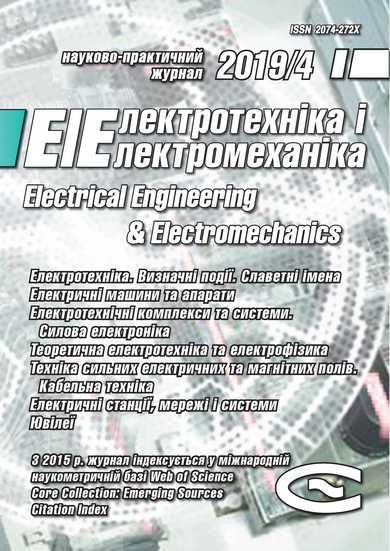INVESTIGATION OF AMPLITUDE-TEMPORAL CHARACTERISTICS OF A HIGH-VOLTAGE RESISTIVE VOLTAGE DIVIDER
DOI:
https://doi.org/10.20998/2074-272X.2019.4.09Keywords:
voltage divider, high-voltage pulse generator, computer simulation, electrical circuit, rise time, transient response, pulse frontAbstract
Purpose. Determination of the possibility of using the developed autonomous voltage divider for measuring high-voltage pulses with sharpened fronts (down to 1 ns). Methodology. We use the technique to determine the division ratio of the divider using a calibrated oscillator and oscilloscope. To determine the rise time of the transition characteristic of the divider, we use an experimental technique based on a high-voltage pulse generator with a steep front and computer simulation using circuit program Micro-Cap. Results. Oscillograms of high-voltage nanosecond pulses with subnanosecond fronts are experimentally obtained using an autonomous resistive voltage divider. A computer simulation of the operation of the created divider in various modes is carried out. Originality. We have shown that an autonomous shielded resistive high-voltage voltage divider can have a rise time less than 1 ns. The values of the parasitic parameters of the divider, which lead to a distortion of the sharpened pulse front with a rise time of ≈0.1 ns, are established. Practical value. The divider can be used to measure the characteristics of high-voltage pulses with a steep front (up to 1 ns as the lower limit).References
Mesiats G.A. Impul'snaia energetika i elektronika [Pulsed power and electronics].Moscow, Nauka Publ., 2004. 704 p. (Rus).
Shvab A. Izmereniia na vysokom napriazhenii. Izmeritel'nye pribory i sposoby izmereniia [Measurements at high voltage. Measuring instruments and methods of measurement].Moscow, Energoatomizdat Publ., 1983. 264 p. (Rus).
Kuffel E., Zaengl W.S., Kuffel J. High Voltage Engineering (Fundamentals). Second edition. Oxford, Butterworth-Heinemann Publ., 2000. 539 p.
Parks H. High-Voltage Divider Calibration with the Reference Step Method. NCSLI Measure, 2016, vol.11, no.1, pp. 34-36. doi: 10.1080/19315775.2016.1149008.
Early M.D., Sira M., Andersson B.-O., Christian L.A., Gunnarsson O., Rydler K.-E., Streit J. A Simple Build-Up Method for the DC Voltage Scale of a Source. IEEE Transactions on Instrumentation and Measurement, 2013, vol.62, no.6, pp. 1600-1607. doi: 10.1109/TIM.2012.2230734.
Boyko N.I., Safronov I.A., Tondii L.D. ASHEMIT: A device for wideband electromagnetic pulse therapy. Instruments and Experimental Techniques, 2000, vol.43, no.5, pp. 675-682. doi: 10.1007/bf02759082.
Demirchian K.S., Neiman L.R., Korovkin N.V., Chechurin V.L. Teoreticheskie osnovy elektrotekhniki: V 3-kh t. Uchebnik dlia vuzov. Tom 2 [Theoretical bases of electrical engineering. In 3 vols. Vol.2.]. St. Petersburg, Piter Publ, 2004. 576 p. (Rus).
Downloads
Published
How to Cite
Issue
Section
License
Copyright (c) 2019 N. I. Boyko, S. O. Syomkin

This work is licensed under a Creative Commons Attribution-NonCommercial 4.0 International License.
Authors who publish with this journal agree to the following terms:
1. Authors retain copyright and grant the journal right of first publication with the work simultaneously licensed under a Creative Commons Attribution License that allows others to share the work with an acknowledgement of the work's authorship and initial publication in this journal.
2. Authors are able to enter into separate, additional contractual arrangements for the non-exclusive distribution of the journal's published version of the work (e.g., post it to an institutional repository or publish it in a book), with an acknowledgement of its initial publication in this journal.
3. Authors are permitted and encouraged to post their work online (e.g., in institutional repositories or on their website) prior to and during the submission process, as it can lead to productive exchanges, as well as earlier and greater citation of published work.





